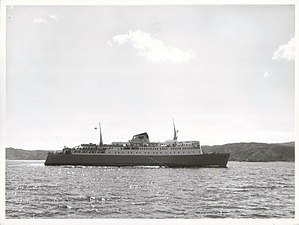GMV Aramoana
 GMV Aramoana in Wellington Harbour, 1965
| |
| History | |
|---|---|
| Name | Aramoana |
| Namesake | Māori: Sea Pathway |
| Builder | William Denny & Brothers Ltd, Dumbarton |
| Cost | $NZ 4 million |
| Yard number | 1502 |
| Launched | 24 November 1961[1] |
| Completed | 1961 |
| In service | 13 August 1962 |
| Identification | IMO number: 5021671 |
| Fate | Laid up 1983, sold 1984 |
| Status | Scrapped at Alang in 1994 |
| General characteristics | |
| Tonnage | 4,160 GRT |
| Length | 112.2 m (368 ft) |
| Beam | 18.6 m (61 ft) |
| Draught | 4.73 m (15.5 ft) |
| Installed power | 6 × English Electric 16CSVM diesel engine |
| Propulsion | 4 * Electric drive motors, 2 per shaft[2] |
| Speed | 19 knots (22 mph) |
| Capacity |
|
| Crew | 90 |
GMV Aramoana (a Māori-language word meaning "Sea Pathway") was a roll-on roll-off train ferry operating across Cook Strait between 1962 and 1983.
History
Government Motor Vessel[3] (GMV) Aramoana was built in 1961 for the New Zealand Railways Department to link the North and South Island rail networks. She was the last vessel built by William Denny and Brothers, Dumbarton, on the River Clyde.[4] In 1965, she was joined by the similar, but slightly larger, Aranui.
On 10 April 1968 Aramoana was the largest of the rescue vessels when TEV Wahine, a New Zealand inter-island ferry of the Union Company, foundered after striking Barrett Reef at the entrance to Wellington Harbour.[5][6] Aramoana's two motor lifeboats were lost in the very heavy seas.[citation needed]
In 1978 Aramoana was rebuilt at Singapore to carry 800 passengers to meet the increased traffic, following the withdrawal in 1976 of the Union Company's Wellington to Lyttelton service.[7]
In 1983, both Aramoana and Aranui were replaced by the significantly larger MV Arahura and were sold to the Najd Trading & Construction Company of Jeddah, Saudi Arabia in 1984. Aramoana was renamed Captain Nicolas V, and renamed Najd II the following year.
Aramoana was laid up at the United Arab Emirates port of Ajman in 1993. In 1994 she left Ajman towed by a tug and was broken up on Alang beach on the western shore of the Gulf of Khambhat in Gujarat state, India.
Layout
A combined vehicle deck could carry 70 cars and 30 rail wagons.
Service
Aramoana was built to provide a railway service between the North and South Islands of New Zealand, later known as the Interislander. Initially she provided one round trip per day (except Sunday).[8] In her first year of service she carried 207,000 passengers, 46,000 cars and 181,000 tonnes of cargo. This was substantially more than her predecessor, the Union Steam Ship Company's ferry Tamahine, which had carried 60,000 passengers, 11,000 cars and 14,000 tonnes of cargo in the final year of service.[3]
In 1985 she carried Muslim pilgrims on the Red Sea.
See also
References
- ^ "MV Aramoana". Shipping Times. Archived from the original on 19 December 2011. Retrieved 21 August 2011.
{{cite web}}: CS1 maint: unfit URL (link) - ^ Stott, Bob (1981). The Cook Strait Ferry Story. Southern Press. p. 44. ISBN 0908616015.
- ^ a b "Cook Strait Rail Ferries". New Zealand History Online. Retrieved 21 August 2011.
- ^ "MV Aramoana". New Zealand Maritime Index. Retrieved 21 August 2011.
- ^ Robinson, Murray. "The Wahine". Retrieved 26 February 2012.
- ^ Castell, Marcus (2003–2007). "The Turbo Electric Vessel WAHINE, 1966-1968". The New Zealand Maritime Record. Retrieved 22 May 2013.
- ^ "New Zealand's Cook Strait Rail Ferries". NZ National Maritime Museum. Retrieved 26 February 2012.
- ^ "The floating bridge - Cook Strait ferries". New Zealand History Online. Retrieved 21 August 2011.
